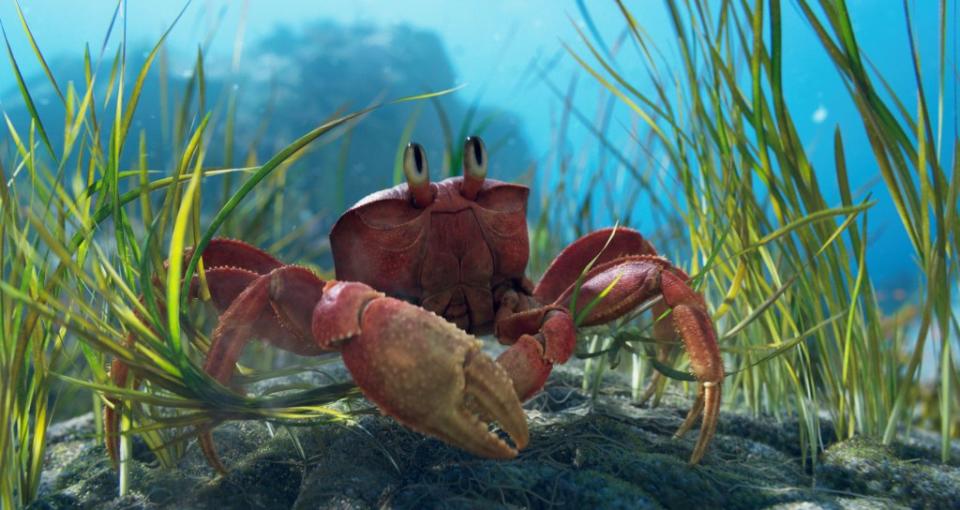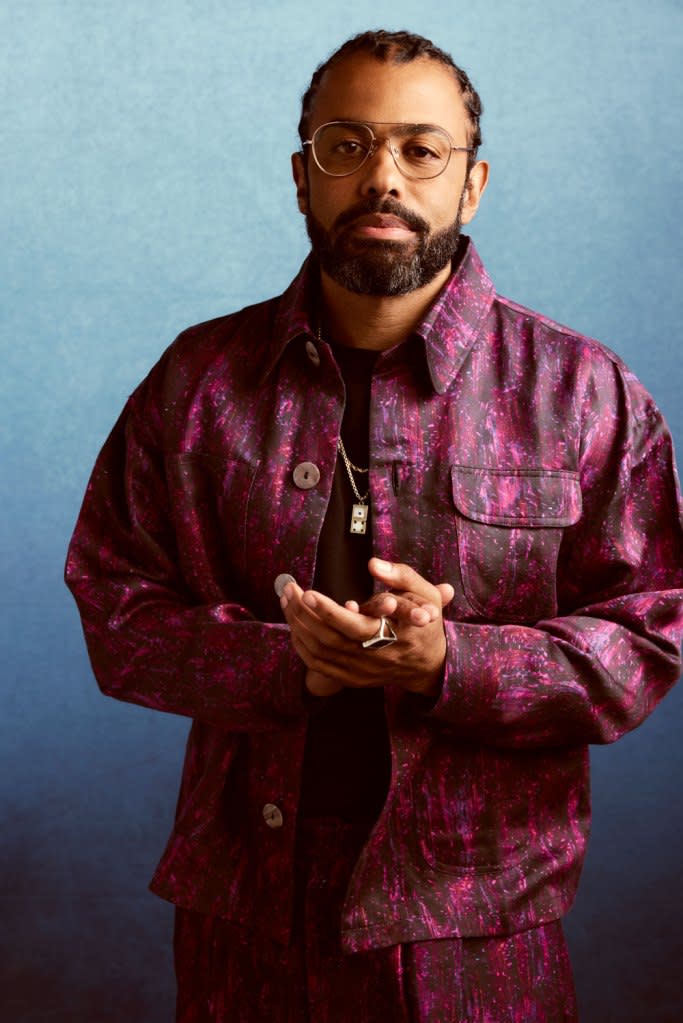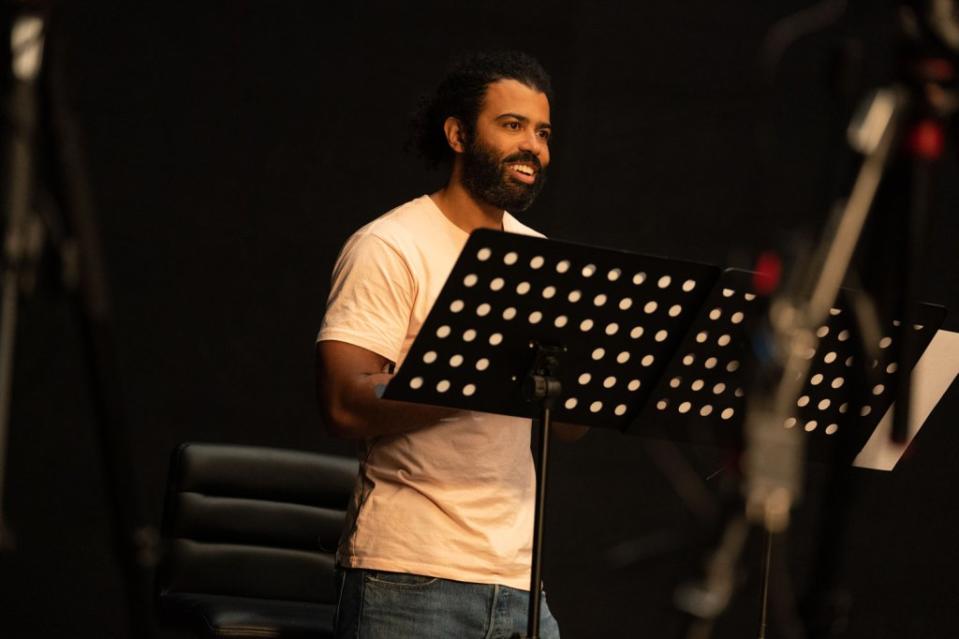Daveed Diggs Is No Imitation Crab: How the Tony Winner Found His Version of Sebastian in ‘The Little Mermaid’
- Oops!Something went wrong.Please try again later.
- Oops!Something went wrong.Please try again later.
- Oops!Something went wrong.Please try again later.

In 1989, the 7-year-old Daveed Diggs queued up outside Oakland’s Grand Lake Theatre, his hometown multiplex, to see “The Little Mermaid” with his father, Dountes.
“It must’ve been opening weekend. The line wrapped around the block,” Diggs recalls. “I remember loving Scuttle, thinking he was just the funniest thing I’d seen up to that point, and loving the songs.”
More from Variety
'The Little Mermaid' Stars Melissa McCarthy and Javier Bardem Play 'Name That Fish!'
Box Office: 'The Little Mermaid' Swimming to $120 Million-Plus Over Memorial Day Weekend
Thirty years later, Diggs is a Tony- and Grammy-winning actor, rapper and filmmaker, best known for “Blindspotting” (both the 2018 film and the Starz series) and “Hamilton,” where he delighted Broadway audiences by putting his unique imprint on Thomas Jefferson and the Marquis de Lafayette. After playing those historical figures night after night, one might imagine he’d have no qualms about taking on another well-known character — the calypso-singing crab Sebastian in Disney’s live-action “The Little Mermaid,” which opens on May 26.
But Diggs’ insecurities — much like Sebastian’s persistent worries — nearly got the best of him. When his reps called to say director Rob Marshall wanted him to audition, Diggs tried to pass, believing the filmmakers were just asking to be nice. After workshopping a couple scenes and songs with Marshall and producer John DeLuca, he still didn’t think he’d get the part. “It took a long time to register,” Diggs admits.
That’s because whenever he imagined Sebastian, Diggs would hear stage and screen star Samuel E. Wright’s Jamaican-accented baritone. “That performance is a thing that sits with me,” Diggs says in wonder at the prospect of a shared legacy with the actor who voiced the role in the 1989 animated classic. “I don’t know if this [version] is gonna work like that for kids — we’ll see.”
Once he overcame his anxieties, Diggs dove into creating the character — as he does for our Zoom conversation hours before the film’s U.K. premiere. For the occasion he’s wearing a deep-red suit with a seabed pattern and a fishbone brooch affixed to his jacket. He says he was detailed and deliberate when developing the accent for Sebastian. In a tribute to Wright’s performance, his crustacean is from the Caribbean too. But the voice has a Trinidadian tinge, influenced by the late playwright Tony Hall, a native of the island, who schooled Diggs on calypso history before he died in 2020.
“Vocally, what we ended up on is a nod to the Sebastian that everybody knows and loves but also is what my voice is capable of doing, both singing and speaking,” Diggs says. “It was this process of trying things out with the various coaches to get a thing that feels consistent with who this crab is.”

Key to the character’s personality is his musical ability. Sure, Ariel — the titular mermaid — is the star, but Sebastian steals the show with two major numbers, “Under the Sea” and “Kiss the Girl.” Plus, for the live-action version, composer Alan Menken and lyricist Lin-Manuel Miranda (Diggs’ “Hamilton” co-star and creator) penned a new track, “The Scuttlebutt,” which features Scuttle (Awkwafina) and Sebastian in a speed-rap cadence as its grand finale. Given their familiarity, pulling that track together was easy, with Miranda delivering the gist of Diggs’ bars over Facetime from an airport.
“His speech patterns are so familiar to me,” Diggs explains. “Rap music, for people who don’t make rap music, feels like a magic trick. But it’s just like anything else.” He gives the lion’s share of the praise to Awkwafina, saying she did all the heavy lifting. “Her performance is insane — to be doing what she’s doing in that voice and all those characterizations,” he adds. “The rap battle [between us] at the end is just icing on the cake, like candy. It didn’t take much work.”
“Under the Sea,” however, was particularly daunting given that Diggs isn’t a trained vocalist. “I was super nervous about it,” Diggs admits, but in rehearsals, Marshall and Menken encouraged him to make it his own. “If I ever did anything that deviated from the original, Alan and Rob would smile” — his cue to keep going. As for recording the track with Halle Bailey — Ariel provides background vocals in the updated arrangement — Diggs has one word: “Unfair.”
“You’re not competing with that voice,” Diggs says, chuckling. “She just happened to be in the room when we were recording, and [Menken] was like, ‘Get in there and riff.’ I said, ‘C’mon man, really? Can I have a moment?’ But it’s my favorite part of the song.”
There was a bit of added pressure too, since Diggs finished recording the track on March 20, 2020, with the COVID-19 lockdown looming. “That was the last thing I had to do,” he recalls. “My partner was like, ‘You have to get on a plane, they’re going to close the borders.’” Like most people at the time, he figured it’d just be a couple of weeks and then right back to work. Instead, he says, “That was the last time I got to perform music until this year when my band [the experimental hip-hop group Clipping] went back out on tour.”

Of course, this interview comes amid another type of shutdown, as the writers strike marches on. Alongside Rafael Casal, Diggs is the co-creator of Starz’s “Blindspotting,” which follows the events of the 2018 film and stars Jasmine Cephas Jones. “I’m really proud of this season,” he says of the show. Diggs made a cameo in the May 12 episode — an ambitious hour directed by Casal that put its characters in a spaghetti Western — and the Season 2 finale airs on May 26, the same day “The Little Mermaid” hits theaters.
Since “Hamilton,” Diggs has racked up first-rate TV roles, including “Snowpiercer,” “Black-ish,” “Central Park,” “The Get Down” and “The Good Lord Bird.” But, lately, he’s been making movies, a transition he’s embraced. “It’s nice to get to do these things that are contained, where I get to create a brand new performance every time” he says, excitedly.
Earlier this year, Variety exclusively reported that Diggs landed a starring role in Andrew Stanton’s live-action sci-fi film “In the Blind of an Eye,” opposite Kate McKinnon and Rashida Jones, and he’s got a couple other movies in the various stages of development. Plus, Diggs is part of an all-star voice cast for the “Trolls” franchise’s third film, “Trolls Band Together,” out in November. He voices Spruce, brother to and BroZone bandmate with Justin Timberlake’s Branch.
“What I have been really aware of all year is feeling really fortunate that there’s so much great writing out there,” Diggs says. “And, as a supporter of the WGA, it’s just important to point out that this stuff doesn’t exist without these scripts, so, we need to work out this agreement and make sure that writers are getting compensated fairly.”
That brings us back to “The Little Mermaid” — adapted by David Magee from the original story by Hans Christian Anderson and the animated film’s screenplay from Ron Clements. “Every experience is additive,” Diggs says of his approach to work. “Every time you do something, you hopefully keep pieces of it with you as you go on to do the next thing.” In this case, his big takeaway was the importance of fostering a sense of realism on set, even on a production this massive.
A month before filming began, Marshall corralled the cast in London to rehearse, much like the company of a stage musical would. He wanted them to build real relationships so their chemistry would come alive on screen. On the first day, he presented all the bells and whistles the movie would involve: visualizations of what the underwater world and its different characters would look like; the choreography of musical numbers like “Under the Sea”; and how the actors would navigate their wire rigs to swim like mermaids.
Then, the director did something extraordinary. “We went into a room and started rehearsing on sets built out of cardboard boxes,” Diggs recalls. “He immediately made it so small and manageable, and from a process perspective, it’s how everything should be made.”

For Diggs, making art has always been about creating something that feels real for everyone involved. That’s been easy to do when he’s worked on independent films and other smaller-scale productions, those projects where the experience you have is reflected on the screen, because that’s all there is.
“It didn’t have to be true in something that big, but Rob certainly approached the project with that same kind of spirit,” Diggs says. “All the love and joy we felt in that room does feel like its projected and magnified on the screen.”
Diggs finally witnessed the fruits of their undersea labors at the film’s Los Angeles premiere. Watching the photo-realistic musical felt like sensory overload. “I was crying every time Halle opened her mouth,” he says. During the “Under the Sea” scene, he was too captivated by the CGI starfish — whose movement was based on dancers from the Alvin Ailey company — to critique his own vocals: “I was so overwhelmed that it was hard to focus. It took my breath away.”
But he’s already earning rave reviews from the kids in his life. His best friend’s 6-year-old daughter, who attended the premiere, told him how funny she thought Sebastian was, Diggs says, sounding relieved.
As for future musicals, Diggs is letting it flow. “I outpaced my career goals so long ago,” he says. “I am in this rare position for an artist where I feel like I’ve been on a victory lap for quite a while. I feel very, very lucky and get to constantly be surprised by what I might be asked to do — like play an iconic crab.”
Best of Variety
'House of the Dragon': Every Character and What You Need to Know About the 'Game of Thrones' Prequel
25 Groundbreaking Female Directors: From Alice Guy to Chloé Zhao
Sign up for Variety’s Newsletter. For the latest news, follow us on Facebook, Twitter, and Instagram.

